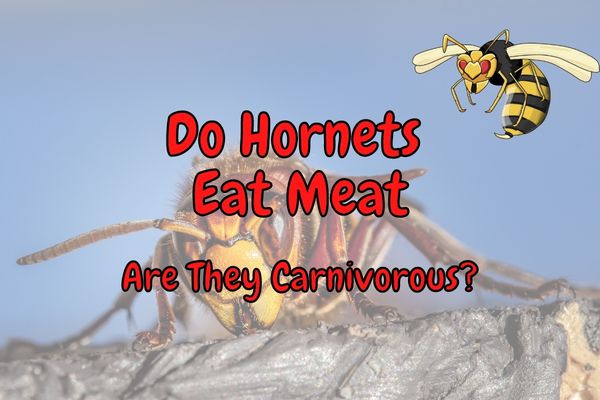Hornets are carnivorous insects that feed on other insects, spiders, and sometimes small vertebrates. Hornets are predators that use their stingers to kill their prey.
Hornets are carnivores and opportunistic feeders that will eat whatever insects they can find. In the wild, they mainly eat bees, wasps, and flies. Their diet changes between seasons, as different food types become more abundant.
Hornets are predatory insects, related to the yellowjacket, that occur throughout the United States and southern Canada.
Hornets are carnivorous insects that live in trees. They are related to wasps and bees, and like them, they have a stinger. Hornets are the largest members of the wasp family.
They look like large wasps and they live and hunt alone, unlike the yellow jackets and paper wasps that live together in colonies. They are easily distinguished from yellow jackets and paper wasps by their longer, thicker midsection.
Contents
Do Hornets Eat Meat?
Before we embark on our exploration, let’s establish a foundational understanding of hornets. The term “hornet” typically refers to the larger species of social wasps in the genus Vespa.
While there are several species of hornets, such as the Asian giant hornet (Vespa mandarinia) and the European hornet (Vespa crabro), their behavior and eating patterns share certain commonalities.
Now, when it comes to the diet of hornets, it’s important to note that these impressive insects are primarily carnivorous, meaning they obtain a significant portion of their sustenance from animal sources. Hornets are renowned predators, and they exhibit a remarkable ability to capture and consume a wide array of prey items.
In their quest for nourishment, hornets typically target other insects as their primary source of protein.
They are formidable hunters, employing their keen vision and agility to locate, pursue, and capture their unsuspecting victims. From caterpillars and flies to bees and other wasps, hornets possess the necessary adaptations, such as powerful jaws and stingers, to overpower and subdue their prey.
However, hornets are not solely reliant on live insects for their meaty meals. They are opportunistic feeders and will readily scavenge for carrion, which refers to the decaying flesh of dead animals.
Carrion provides a valuable source of protein, and hornets are known to exploit this resource whenever it becomes available in their environment. So, if you stumble upon a deceased creature in the wild, don’t be surprised if hornets are among the visitors paying their respects, so to speak.

Interestingly, while hornets predominantly feed on insects and carrion, there have been instances where they’ve demonstrated a willingness to consume other meat sources.
For example, if you were to leave a succulent steak or any other tantalizing piece of meat outside, it’s not entirely out of the realm of possibility that hornets might take an interest in it.
However, it’s worth noting that this behavior might not be as common as their preference for insects or carrion.
In conclusion, hornets are indeed meat-eaters, with a primary focus on other insects and the occasional indulgence in carrion.
Their remarkable hunting abilities and opportunistic nature make them versatile predators in their ecosystems. So, whether they’re swooping down on unsuspecting prey or scavenging for nourishment, hornets are undeniably fascinating creatures that have carved their niche as consummate carnivores in the insect world.
Are Hornets Considered Predators?
Yes! Hornets are beneficial predators that prey on many living animals – mostly insects. They prey on other insects, including stinkbugs, caterpillars, and flies, and even on spiders, scorpions, and centipedes in some habitats. They also prey on peaceful herbivorous honeybees and can sometimes leave behind a massacre near the beehive.
Hornets have a very efficient digestive system that allows them to extract all the nutrients from their prey. This makes them an important part of the ecosystem since they help to recycle nutrients back into the environment via the decomposers that eat them when they die.
Some of the biggest hornet species in the US are the Bald-faced Hornets (although they are actually not true hornets but yellowjackets!). Baldfaced hornets feed on insects, tree sap, fruit, and garbage.
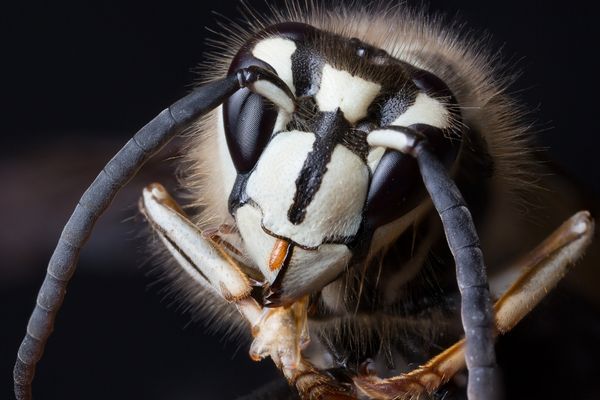
The baldfaced hornet (Dolichovespula maculata) is 2 to 3 inches long. It is black with white markings on its face, and it may have orange markings, as well.
Baldfaced hornets construct their nests in trees or shrubs. The nest of baldfaced hornets consists of multiple hanging combs, or segments, made of paper-like material. Each comb contains one to five cells, which house the larvae. The hive can contain up to 3,000 individuals!
If you are interested, you can read much more about the types of hornets found in the US, and about their nests in my recent post.
Are Hornets Carnivores, Herbivores or Omnivores?
Hornets are mostly carnivores, because they primarily eat other living animals.
Hornets eat insects and other arthropods, like spiders and ticks. It is very rare that hornets feed on plants or fruit.
But the queen hornet will often supplement with plant material and sometimes pollen and plant sap as well.
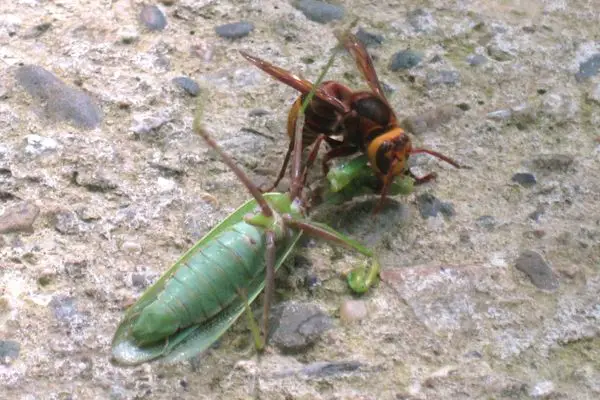
To understand the feeding preferences of hornets, it’s essential to delve into their natural behavior and examine their dietary choices.
Hornets, commonly known as predatory wasps, belong to the genus Vespa, and their eating habits are influenced by their role as carnivorous insects.
Hornets are unequivocally classified as carnivores, meaning they primarily consume other animals as their main source of sustenance. As predators, they exhibit a remarkable skill set specifically adapted for hunting and capturing prey.
Their diet mainly consists of insects, such as bees, flies, caterpillars, and other arthropods. Hornets possess formidable hunting capabilities, utilizing their sharp mandibles to seize and incapacitate their victims swiftly.
Interestingly, hornets are known to exhibit opportunistic feeding behaviors, which means they may take advantage of available food sources when they arise. While their primary diet revolves around hunting other insects, hornets may occasionally scavenge carrion, which refers to the decaying flesh of dead animals.
This behavior can be observed when a dead animal is encountered, presenting an easy and accessible meal for the hornets.
While hornets primarily rely on live prey, they do possess a level of dietary flexibility. If a steak were left outside, it might indeed attract hornets, particularly if it emits a strong odor or if they perceive it as an opportunity for an easy meal.
However, it’s important to note that such occurrences are relatively rare and not a typical part of their diet.
In summary, hornets are unequivocally classified as carnivores due to their main diet consisting of other insects. Their feeding habits revolve around hunting and capturing live prey, displaying exceptional predatory skills.
While they may exhibit opportunistic behaviors and scavenge carrion, such occurrences are infrequent. So, while a hornet may show interest in a steak left outside, it is not representative of their usual dietary preferences.
Is a Hornet a Producer, Consumer or Decomposer?
A hornet is a consumer because it eats other living things. It is tertiary consumer as it also eats other predatory animals.
Firstly, it is important to establish the definitions of each of these ecological roles. In ecological terms, a producer refers to an organism that is capable of producing its own food through photosynthesis or chemosynthesis.
These autotrophic organisms, such as plants, algae, and certain bacteria, utilize sunlight or inorganic compounds to synthesize organic molecules, thereby serving as the primary source of energy for an ecosystem.
On the other hand, a consumer is an organism that obtains its energy by consuming other organisms. These heterotrophic organisms can be further classified into different trophic levels based on their feeding habits.
For example, herbivores are primary consumers that feed directly on plants, while carnivores are secondary or tertiary consumers that consume other animals.
Lastly, decomposers are crucial players in the ecosystem as they break down organic matter, such as dead plants and animals, into simpler substances. Decomposers, primarily composed of bacteria and fungi, perform the vital role of recycling nutrients back into the ecosystem, allowing them to be reused by producers for growth and development.
Now, let’s consider the Hornet in light of these ecological roles. The Hornet, scientifically known as Vespa, belongs to the family Vespidae and is a type of predatory wasp. It is important to note that Hornet species can vary in their behavior and ecological roles, so we will focus on the general characteristics exhibited by most Hornets.
Hornets are considered consumers within the ecological framework. They are classified as carnivores and primarily feed on other insects, including bees, flies, and other wasps. Their diet consists mainly of protein-rich prey, which they capture using their powerful mandibles and stingers. Hornets play a significant role in regulating insect populations within their habitats, contributing to the overall balance and stability of ecosystems.
While Hornets are not directly involved in the processes of photosynthesis or chemosynthesis, which are characteristic of producers, they indirectly depend on the energy captured by producers. The energy stored in the bodies of the insects they consume originates from plants or other autotrophic organisms.
As secondary consumers, Hornets rely on the energy passed on through the food chain from primary consumers, such as herbivorous insects that feed directly on plants.
As for decomposition, Hornets do not actively participate in this process. Decomposition is primarily carried out by specialized organisms, such as bacteria and fungi, which break down organic matter into simpler compounds. These decomposers play a crucial role in nutrient cycling, releasing essential elements back into the environment for uptake by producers. While Hornets may contribute to decomposition indirectly by occasionally preying on dead insects, their impact on the process is minimal compared to the specialized decomposer organisms.
In summary, Hornets are consumers, specifically carnivores, within the ecological framework. They rely on the energy obtained by consuming other insects, but they do not actively participate in the process of producing their own food or decomposing organic matter.
By understanding the ecological roles of different organisms like the Hornet, we can gain a deeper appreciation for the intricate web of life and the interconnectedness of all living beings within ecosystems.
Are Hornets Scavengers?
Yes! Hornets will scavenge for dead insects and even larger dead birds, reptiles, and mammals. They do, however, prefer to eat living prey.
As a biologist I did my graduate research in hornet dietary habits, I can confidently provide you an elaborate explanation regarding the scavenging behavior of hornets.
Hornets, which belong to the Vespa genus, are a group of social wasps known for their aggressive nature and distinct physical characteristics.
They are predatory insects that primarily feed on other arthropods, such as insects, spiders, and even bees. However, the question of whether hornets can be classified as scavengers requires a nuanced understanding of their foraging behavior and dietary preferences.
Hornets are predators by nature and typically engage in active hunting to capture and kill their prey. They have a well-developed hunting strategy, often targeting insects that can provide a substantial source of food for their colony.

This includes larger insects like beetles, grasshoppers, and caterpillars. Hornets use their strong mandibles to immobilize their prey and their potent venom to paralyze them, making it easier to transport them back to their nest. This predatory behavior suggests that hornets primarily rely on freshly caught prey for their sustenance.
However, it is worth noting that hornets also demonstrate a certain level of opportunistic behavior when it comes to food sources. While their primary mode of feeding is through predation, they are known to scavenge under certain circumstances.
Scavenging can be defined as the consumption of decaying organic matter or food that has been abandoned or left behind by other organisms. In the case of hornets, they may occasionally scavenge on animal carcasses or exploit other available food sources in the environment.
In situations where fresh prey is scarce or not readily available, hornets may resort to scavenging as a means of survival. This behavior is more commonly observed in late summer or early autumn when resources may become limited.
During these times, hornets can take advantage of carrion, such as dead insects or even small vertebrates. They are attracted to the odor of decomposing matter, which they can detect using their keen sense of smell. However, it is important to emphasize that scavenging is not their primary mode of obtaining nutrition.
The ability of hornets to scavenge, although not their dominant foraging strategy, highlights their adaptability and opportunistic tendencies. While they are primarily hunters, they can resort to scavenging when necessary to ensure the survival and sustenance of their colony.
This flexibility in feeding behavior allows hornets to exploit various food sources, especially during periods of scarcity or when the opportunity presents itself.
In conclusion, hornets are primarily predators that rely on actively hunting and capturing live prey. However, they also possess the capability to scavenge under specific circumstances, such as when fresh prey is scarce or during certain times of the year.
Scavenging behavior, although not their main foraging strategy, showcases the adaptability of hornets and their ability to exploit available resources for survival.
Where are Hornets in the Food Chain?
Hornets are tertiary consumers because they eat other animals that eat other animals. Therefore they are at the 3rd trophic level of the energy pyramid, placing them somewhere in the middle of the food chain.
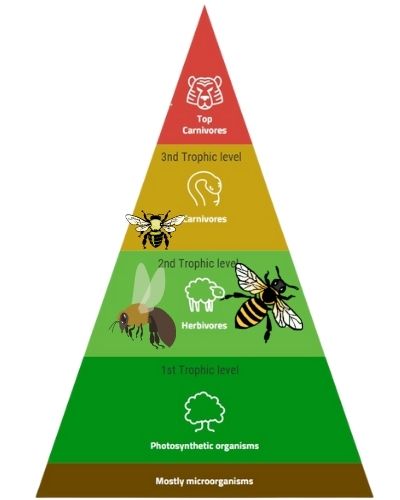
First and foremost, it is important to note that hornets belong to the order Hymenoptera, which includes wasps, bees, and ants.
These insects are highly diverse and exhibit various ecological roles. Hornets, specifically, are large wasps belonging to the genus Vespa and are known for their aggressive nature and powerful stings.
In terms of the food chain, hornets occupy a distinctive position as secondary consumers. They are primarily carnivorous and feed on a wide range of creatures, including insects, spiders, and other arthropods.
Hornets are especially notorious for hunting and preying on honeybees, which they capture and bring back to their nests as food for their larvae.
This predatory behavior has earned them a reputation as a threat to bee populations and has sparked concern among beekeepers and environmentalists alike.
However, it is important to note that hornets themselves are not immune to predation. While they are formidable insects with powerful stingers and venomous capabilities, they still have natural predators in their environment. Among their predators are birds, particularly those with insectivorous diets such as kingfishers, woodpeckers, and swallows. These avian predators rely on hornets as a source of sustenance, incorporating them into their diet and playing a crucial role in regulating hornet populations.
Furthermore, hornets may also fall victim to mammalian predators, including bears, badgers, and other small carnivores.
These animals may opportunistically feed on hornets or their nests, especially during times when other food sources may be scarce. In some cases, even humans can be considered predators of hornets, as certain cultures include them as a delicacy or use them for medicinal purposes.
Apart from being preyed upon, hornets also face competition from other members of the food chain. Bigger wasps, spiders, and larger predatory insects may vie for similar food resources, such as other insects or nectar from flowers. This competition for resources helps maintain a delicate balance within the ecosystem and ensures that hornets are not the sole dominant force in their respective habitats.
In conclusion, hornets, as secondary consumers, hold a significant place in the food chain. Their carnivorous nature allows them to prey upon a variety of insects and spiders, including honeybees. However, hornets themselves are not immune to predation and face threats from birds, mammals, and even humans.
Additionally, they also compete with other predators for resources. Understanding the role of hornets in the food chain is crucial for comprehending the intricate web of interactions that shape ecosystems and underscores the importance of maintaining a healthy balance among all organisms.
Are Hornets Autotrophs or Heterotrophs?
Hornets are heterotrophs. Heterotrophs are organisms that cannot produce their own food through photosynthesis or other similar processes. Instead, they rely on consuming organic matter from external sources to obtain the energy and nutrients they need for survival.
As carnivorous insects, hornets primarily obtain their energy and nutrients by feeding on other living organisms. They are carnivorous heterotrophs, specifically known for hunting and preying upon insects, spiders, and other arthropods. Hornets are equipped with specialized mouthparts and powerful mandibles that allow them to capture and consume their prey.
Unlike autotrophs, such as plants, which can synthesize their own food from sunlight, water, and carbon dioxide, hornets do not possess the necessary structures, such as chloroplasts or photosynthetic pigments, to carry out photosynthesis. Therefore, they must actively seek out and capture their food to meet their metabolic requirements.
It’s worth noting that while hornets are heterotrophs, they may occasionally consume other food sources besides insects and arthropods. For example, some hornet species may feed on nectar or sap from plants as an additional energy source. However, their primary diet consists of animal matter, making them predominantly carnivorous heterotrophs.
In summary, hornets are heterotrophs that obtain their energy and nutrients by consuming other organisms, predominantly insects and arthropods. They do not possess the ability to produce their own food through photosynthesis like autotrophs do.
Why are Hornets Important for the Ecosystem?
Hornets play an important role in the ecosystem due to their ecological contributions and interactions. Understanding their significance helps us appreciate the broader ecological web and the impacts of their presence or absence. Here are some reasons why hornets are important for the ecosystem:
- Predator-Prey Dynamics: Hornets are skilled predators, and their primary prey includes insects and arthropods such as bees, flies, caterpillars, and spiders. By actively hunting and controlling populations of these potential pests, hornets help regulate their numbers. This predator-prey dynamic is crucial for maintaining a balanced ecosystem and preventing outbreaks of certain insect species.
- Pollination: While hornets are primarily carnivorous, some species may inadvertently contribute to pollination. When hornets visit flowers in search of nectar or alternative food sources, they can transfer pollen from one flower to another, aiding in the fertilization process and promoting plant reproduction. While their role in pollination is relatively minor compared to bees or other specialized pollinators, it still contributes to the overall diversity and stability of plant populations.
- Resource Recycling: Hornets, like other organisms, contribute to the process of resource recycling and decomposition. When hornets capture and consume insects and arthropods, they break down their prey’s organic matter and release nutrients back into the environment. This nutrient cycling helps replenish soil fertility and facilitates the growth of plants and other organisms.
- Prey for Other Species: Hornets serve as a source of food for various predators in the ecosystem. Birds, such as kingfishers, woodpeckers, and swallows, often feed on hornets. Mammalian predators like bears, badgers, and small carnivores may also opportunistically prey upon hornets. By being part of the food chain, hornets provide nourishment to these predator species and help sustain their populations.
- Biodiversity and Balance: Hornets contribute to the overall biodiversity of ecosystems. Their presence adds to the richness and complexity of species interactions within a given habitat. Biodiversity plays a crucial role in maintaining the resilience and stability of ecosystems, as different species depend on each other for various ecological services.
It is important to note that while hornets offer these ecological benefits, their impacts can vary depending on the specific ecosystem and region. In certain cases, their predatory behavior can pose challenges to honeybee populations, especially in areas where honeybee conservation is a concern. Therefore, a balanced understanding of their ecological role helps us appreciate their contributions while considering the potential implications on other species of interest.
In conclusion, hornets are important for the ecosystem due to their role in regulating prey populations, potential contributions to pollination, nutrient recycling, being a food source for other species, and maintaining biodiversity and ecological balance. Their presence contributes to the intricate web of interactions within ecosystems, highlighting the interconnectedness and interdependence of species.
Do Hornets have any natural predators?
Hornets, like many insects, have a number of natural predators, such as frogs, lizards, birds, racoons, and larger spiders. A weak hornet may also be attracted by ants or other hornets!
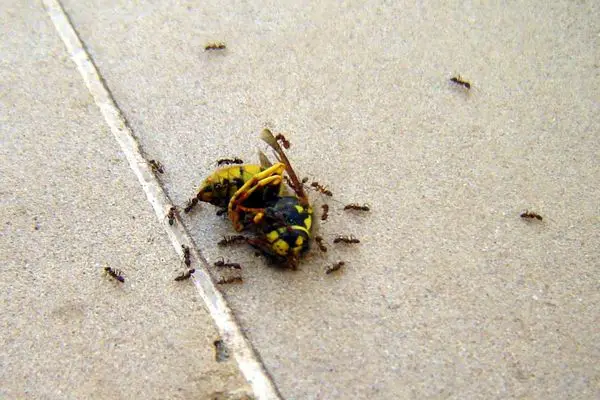
While hornets are formidable insects with powerful stingers and venomous capabilities, they are not immune to predation. Various organisms rely on hornets as a food source, contributing to the balance and dynamics of their populations.
Here are some examples of hornet predators:
- Birds: Certain bird species are known to prey on hornets. Avian predators such as kingfishers, woodpeckers, swallows, and bee-eaters have been observed feeding on hornets. These birds have adaptations suited for capturing and consuming flying insects, including hornets. They are capable of catching hornets mid-air or extracting them from their nests. Birds play a crucial role in regulating hornet populations by incorporating them into their diet.
- Mammals: Several mammalian predators may opportunistically feed on hornets or their nests. Bears, badgers, and other small carnivores are known to consume hornets as part of their diet. These mammals may raid hornet nests for their larvae or feed on individual hornets. While not all mammals actively seek out hornets as prey, they may take advantage of them as a food resource when available.
- Other Insects: Hornets also face competition and predation from other insects. Larger wasps and predatory insects may target hornets as rivals for resources or as potential prey. Some examples include praying mantises, mantidflies, robber flies, and dragonflies. These insects are equipped with specialized hunting adaptations and may engage in predatory interactions with hornets.
- Humans: While not a direct natural predator, humans can also be considered as predators of hornets in certain contexts. In some cultures, hornets are consumed as food or used for medicinal purposes. Human activities such as nest removal or pest control measures can result in the reduction or elimination of hornet populations.
These natural predators contribute to the regulation of hornet populations within their ecosystems. They help control hornet numbers, maintain ecological balance, and prevent excessive population growth.
The presence of these predators ensures that hornets do not become overly dominant and helps sustain the diversity and stability of the surrounding ecological communities.
It is important to note that the specific predators of hornets can vary depending on the region and the particular hornet species.
The interactions between hornets and their predators are influenced by factors such as habitat, available prey, and the predator’s adaptations.
Hornets can actually also eat other hornets, but usually only the larvae, but sometimes they go for the queens of another colony.
The worker hornets, which are the only hornets you have probably seen, usually eat insects and can therefore easily eat smaller hornet species or their larvae.
Conclusion
In this post I have looked into the details of hornet’s diets and how these pack hunters are determined predators.
Hornet’s are expert predators, hunting live prey rather than scavenging on the remains of other, dead animals. They hunt a wide variety of creatures from insects to spiders and even small lizards!
As hornets hunt live prey, they have an amazing ability to be able to locate and catch their targets.
They are extremely successful predators but are still quite vulnerable as humans take more of their habitat (forests etc.), which may have consequences for the ecosystem as a whole.
Hornets eat other insects, such as flies, beetles, moths and caterpillars. They also eat spiders. Hornets are especially fond of tree sap, which they use to make their nests.
The hornet’s saliva contains enzymes that kill bacteria, so they may be classed as decomposers. However, the enzymes in hornet saliva are optimized for breaking down other insects, not bacteria.

